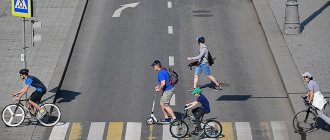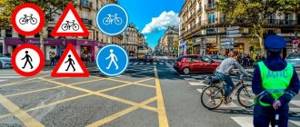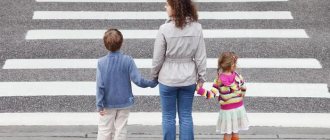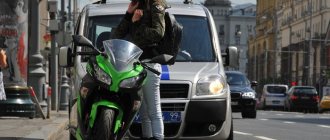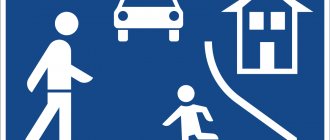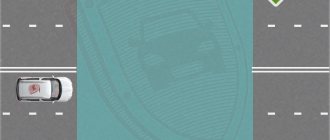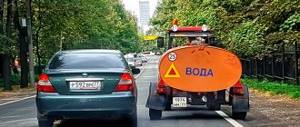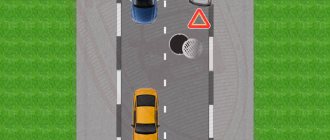Bikers are full-fledged and numerous road users. The system of legal relations regulates the status and responsibilities of a cyclist. But often two-wheeled vehicles cause irritation among car drivers. The bicycle is lost among cars due to its small size and silent movement. According to car enthusiasts, it appears out of nowhere, and the cyclist does not know the rules and does not care about his own safety. To minimize conflict situations, the government approved traffic rules, which are based on the European Concept and national legislation.
Duties of a cyclist
According to statistics, in 2021 there were 5,056 accidents involving bikers. As a result, 382 people were killed and about 5,000 were injured. In 2020, the figure increased by 5%. Driving on a pedestrian crossing and towards oncoming cars, ignoring red traffic lights and turn signals, transporting goods and passengers, and many other violations are the reason for the appearance of a special section in the traffic rules, which stipulates the rights and responsibilities of cyclists on the road. The owner of a two-wheeler must:
- Know and follow traffic rules.
- Monitor the serviceability of the vehicle in accordance with the standard requirements for the technical condition of a bicycle.
- Equip two-wheeled vehicles with a bell and reflectors (white on the front, red on the back, orange lights on the sides).
- Adjust the steering, have reliable brakes.
- Before leaving, check the saddle fastening and inflate the tires.
- Let people pass at crossings.
- Do not be a nuisance on the roads, do not create emergency situations for road users.
- Use special gestures to warn in advance about the cyclist’s desire to change lanes, turn to the side, brake or stop:
- an outstretched arm (right) in the direction of the turn or a left arm bent at the elbow at a right angle indicates the cyclist’s desire to change lanes or turn to the right;
- a change in movement in the other direction is shown with the left hand or the right arm is bent at the elbow at an angle of 90 degrees;
- Before stopping or braking, the biker must raise his straight arm up.
- The cyclist must ensure that the motorist understands his intentions.
- Safety requirements must be observed:
- ride in a single row with other cyclists (up to 10 people);
- drive along the right edge of the road, maintaining a distance of up to 1 m;
- drive around (overtake) cars only on the left side;
- wear personal protective equipment (bicycle helmet, gloves, etc.)
The biker must choose a bicycle path for movement if it is located next to the highway. If there are obstacles (debris, parked cars), move onto the roadway.
What is a bicycle according to traffic rules in 2021?
First of all, you need to determine what a bicycle is from a legal point of view, and how to distinguish it from other types of vehicles (vehicles). The traffic rules give this definition, highlighting several key points:
- At least two wheels.
- The driving force is the muscles of the people driving the vehicle.
- An electric motor is acceptable, but not more powerful than 0.25 kW and with automatic shutdown at speeds above 25 km/h.
Thus, a bicycle is distinguished, on the one hand, from wheelchairs (although they move with the help of muscles, they are not considered vehicles), and on the other, from electric mopeds. Installing an internal combustion engine of any type and power turns a bicycle into either a moped or a motorcycle (tricycle, ATV, etc.). But at the same time, a tandem bicycle or velomobile still belongs to the category of bicycles.
WATCH THE VIDEO
It should be noted that if a cyclist gets off the saddle and drives his vehicle (for example, crossing a zebra crossing), he will be considered only as a pedestrian. The rules relating to the vehicle will not apply to it.
Allowed
Professionals draw attention to the inconsistency of current traffic rules. For example, Candidate of Legal Sciences F. Zeymalov argues: the legal status of a cyclist as a road user needs to be improved. Can a person driving a two-wheeler ride in the outer lane and turn right? Are teenagers allowed to ride on the road or on the side of the road? What should a cyclist do if the directions of travel intersect and the order of priority does not work for the biker?
Place of movement
When describing traffic rules that apply to cyclists, you first need to note the places where they can move.
The permitted places of movement are quite specific. Here are the most basic valid places:
- City bike paths.
- The right edge of the roadway, no further than a meter from the edge or directly along the side of the road. These are equivalent places. When moving along the road on foot, a cyclist must walk with the direction of traffic, and not against it, like pedestrians.
- In the process of moving along the sidewalk, that is, along the pedestrian zone, you can only move if the first two options are missing.
Based on the above, we can conclude that cyclists who move on sidewalks violate the rules.
A bicycle is a vehicle, not a pedestrian on wheels. This rule does not apply to children under 14 years of age. They can move along sidewalks and paths at the same time as pedestrians.
Responsibility of cyclists for traffic violations
The regulations contain basic requirements and sanctions for cyclists who break the law. These are the Traffic Regulations (clause 24) and the Code of Administrative Offenses (Article 12.29). Bikers, like car drivers, are road users. Violations are recorded by the state traffic inspector, who has the right to issue a warning, draw up a report, and issue a fine. Administrative responsibility for driving a two-wheeler by a drunk driver is established in clause 27 of the traffic rules. Tighter sanctions are stipulated in the Code of Administrative Offences.
Fines (from 800 rubles and above) are imposed for violating the rules without causing harm to other persons. If people are injured due to the fault of a cyclist, monetary penalties increase by 200–700 rubles. Administrative responsibility begins at the age of 16.
Here is a list of violations that can be punished:
- creating obstructions on the road;
- driving while intoxicated;
- causing harm to the health of another participant in the movement;
- transportation of cargo that does not correspond to the dimensions of the bicycle;
- turning (turning) on roads with tram traffic;
- intersection of stripes indicating one direction;
- towing of vehicles;
- crossing a pedestrian crossing on a bicycle;
- lack of sound signal and reflectors;
- creating an emergency situation;
- riding a faulty bicycle;
- riding without support on the handlebars or with your legs raised on the frame;
- transportation of passengers.
Is the bike path safe?
Unfortunately, even a bike path, where pedestrians are prohibited by traffic regulations, is not a safe place for cyclists. Unfortunately, pedestrians often ignore, and perhaps are not aware of, the fact that they do not have the right to use bicycle paths. If people feel comfortable walking there, they will walk their children and walk their dogs.
I don’t recommend accelerating on a bike there; in the event of an accident, you will most likely be given mutual blame - like you didn’t do everything to prevent the incident.
Besides this, there is one more thing that makes high-speed riding on a bike path dangerous. The path is crossed from time to time by exits from yards, where drivers are simply not ready to perceive you as a hindrance - firstly, the cyclist is driving faster than usual, secondly, the motorist’s attention is focused on cars passing along the road, thirdly, they are not used to it yet to the fact that you need to let a bicycle pass on the bike path.
Basic provisions
Bicycle traffic is the same organized process as automobile traffic. The current traffic rules apply to all participants, without exception - car drivers, motorcyclists, pedestrians, truck drivers.
The cyclist is obliged to obey the signs regulating traffic:
- priority determination;
- special signs regulating traffic with a dedicated lane for route vehicles, one-way directions, etc.;
- directional signs for participants;
- prohibition signs for various turning maneuvers and entry.
The list includes all the signs that are installed on the road to regulate the movement of participants, as well as road markings prohibiting crossing solid roads, being in areas marked in yellow, and requiring pedestrians to pass at the crossing.
IMPORTANT! While driving, the driver must pay maximum attention to the surrounding environment and be prepared to respond quickly to what is happening on the road.
Lighting devices
Separately, you need to consider what kind of lighting devices can be installed on a bicycle. Unlike cars, the installation of headlights, headlights or other devices not provided by standard does not need to be coordinated - the owner decides what he needs, buys it himself and installs the necessary lighting devices if necessary.
However, in order not to violate traffic regulations, it is best to install the following on your bicycle:
- Headlight. Replacing it with a headlamp on a bike helmet is highly not recommended.
- Red marker for the trunk or rear fender.
Lighting devices can be powered either from a battery or from a “dynamo” - a small-sized electric generator. It is recommended to use battery-powered models: when stopped, the generators stop working and the headlights stop shining.
Age to ride a bicycle
According to the current legislation of our country, there are three age groups of two-wheeler drivers:
- Preschoolers.
Young bicycle riders can ride exclusively on sidewalks (together with pedestrians) under the constant supervision of adults. Of course, a young cyclist must hold the wheel with both hands, let pedestrians pass and go around them without creating interference or danger for them, and have the skills to keep their distance. Before the ride, parents must carry out a technical inspection to ensure that the child’s bike is in good working order and take care of the child’s protection (helmet, protective equipment). The seat must match the height of the child. For safe cycling, you need to equip your bicycle with a flashlight, a bell and reflectors. It is wise to dress your child in clothing with reflective stripes.
- From first class to first passport.
School-aged bicycle riders can ride on sidewalks, bicycle paths, pedestrian and bicycle-pedestrian paths, within pedestrian zones. A young cyclist is only allowed to ride a technically working bicycle, and his behavior must comply with traffic rules.
- From 14 years of age and older.
A bicycle driver who has reached his 14th birthday is considered an adult driver. He acquires the right to ride a bicycle on the roadway under appropriate conditions.
